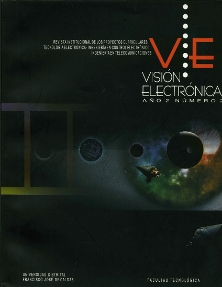DOI:
https://doi.org/10.14483/22484728.18372Publicado:
2018-08-13Número:
Vol. 1 Núm. 2 (2018): Edición especialSección:
Visión InvestigadoraHuman-robot scaffolding architecture
Arquitectura human-robot scaffolding
Palabras clave:
Constructivism, Flow Theory, Human-Robot Interaction, Scaffolding, Social Robots (en).Palabras clave:
Construccionismo, Teoría psicológica del Fluir, Interacción Humano-Robot, Andamiaje, Robots Sociales (es).Descargas
Resumen (en)
This study presents the advances in the design of the architecture called Human-Robot Scaffolding. The Architecture allows an anthropomorphic social robot to intervene assertively during the learning of the Mean-Fines analysis strategy. Its design recognizes three aspects. Firstly, the scaffolding educational strategy. Second, the psychological theory of Flow. Third, the paradigm BDI agents for the execution of the robot's goals. The partial validation of the architecture has been done with 20 children between 10 and 13 years old from two schools in Colombia. According to the results, the modules and the goals proposed in the architecture promote in an assertive way the learning of the Mean-Fines analysis strategy.
Resumen (es)
El documento presenta los avances en el diseño de la arquitectura llamada Human-Robot Scaffolding. La arquitectura permite que un robot social antropomórfico intervenga de manera asertiva durante el aprendizaje de la estrategia de análisis de Medios-Fines. Su diseño reconoce tres aspectos. Primero, la estrategia educativa de andamiaje. Segundo, la teoría psicológica del Fluir. Tercero, el paradigma de agentes BDI para la ejecución de las metas del robot. La validación parcial de la arquitectura ha sido hecha con 20 niños entre 10 y 13 años de dos colegios en Colombia. De acuerdo a los resultados, los módulos y las metas propuestas en la arquitectura promueven de manera asertiva el aprendizaje de la estrategia de análisis de Medios-Fines.
Referencias
D. Fisher and N. Frey, “Guided instruction: How to develop confident and successful learners”, Chicago: ASCD, 2010.
R. D. Pea, “The social and technological dimensions of scaffolding and related theoretical concepts for learning, education, and human activity”, Journal of the learning sciences, vol. 13, no. 3, 2004, pp. 423-451. https://doi.org/10.1207/s15327809jls1303_6.
D. Wood, J. Bruner and G. Ross, “The role of tutoring in problem solving”, Journal of child psychology and psychiatry, vol. 17, no. 2, 1976, pp. 89-100. https://doi.org/10.1111/j.1469-7610.1976.tb00381.x.
L. Harmat, F. Andersen, F. Ullén, J. Wright and G. Sadlo, “Flow Experience: Empirical Research and Applications”, Springer, 2016. https://doi.org/10.1007/978-3-319-28634-1.
B. Kort and R. Reilly, “Analytical models of emotions, learning and relationships: towards an affect-sensitive cognitive machine”, Conference on virtual worlds and simulation, 2002.
K. Chrysafiadi and M. Virvou, “Student Modeling for Personalized Education: A Review of the Literature”, Advances in Personalized Web-Based Education, pp. 1-24. https://doi.org/10.1007/978-3-319-12895-5_1.
B. Crandall, G. A. Klein and R. R. Hoffman, “Working minds: A practitioner's guide to cognitive task analysis”, Mit Press, 2006. https://doi.org/10.7551/mitpress/7304.001.0001.
S. Goldin-Meadow, “Talking and thinking with our hands”, Current Directions in Psychological Science, vol. 15, no. 1, 2006, pp. 34-39. https://doi.org/10.1111/j.0963-7214.2006.00402.x.
N. B. Brooks, D. Barner, M. Frank and S. Goldin-Meadow, “The Role of Gesture in Supporting Mental Representations: The Case of Mental Abacus Arithmetic”, Cognitive Science, vol. 42, no. 2, 2017. https://doi.org/10.1111/cogs.12527.
M. W. Alibali, R. C. Spencer S. Kita and L. Knox, “Spontaneous gestures influence strategy choices in problem solving”, Psychological Science, vol. 22, no. 9, 2011, pp. 1138-1144. https://doi.org/10.1177/0956797611417722.
M. Chu and S. Kita, “The nature of gestures' beneficial role in spatial problem solving”, Journal of Experimental Psychology: General, vol. 140, no. 1, 2011, pp. 102-116. https://doi.org/10.1037/a0021790.
K. Charalampous and C. M. Kokkinos, “The Model of Interpersonal Teacher Behavior: a qualitative cross‐cultural validation within the Greek elementary education context”, British Educational Research Journal, vol. 39, no. 1, 2013, pp. 182-205. https://doi.org/10.1080/01411926.2011.617437.
J. Sweller and M. Levine, “Effects of goal specificity on means–ends analysis and learning”, Journal of experimental psychology: Learning, memory, and cognition, vol. 8, no. 5, 1982, pp. 463-474. https://doi.org/10.1037/0278-7393.8.5.463.
J. E. Turner, R. Waugh, J. J. Summers and C. M. Grove, “Implementing high-quality educational reform efforts: An interpersonal circumplex model bridging social and personal aspects of teachers’ motivation”, Advances in teacher emotion research, 2009, pp. 253-271. https://doi.org/10.1007/978-1-4419-0564-2_13.
D. A. Crovo, “Interfaz RoboAct-pantalla multitáctil para interacción con el usuario en la creación de dramatizaciones de teatro robótico”, thesis, Pontificia Universidad Javeriana, 2018.
V. Parada and D. Steven, “Simulador basado en agentes inteligentes para el apoyo a la toma de decisiones en los planes operacionales de negocios en centros comerciales”, thesis MSc., Pontificia Universidad Javeriana, 2017.
M. A. Bermeo, D. S. Ávila, F. A. Merchán, E. González and A. M. González, “AIO robot: A EDI modular robotic dramatization platform”, 18th International Conference on Advanced Robotics (ICAR), 2017. https://doi.org/10.1109/ICAR.2017.8023528.
Cómo citar
APA
ACM
ACS
ABNT
Chicago
Harvard
IEEE
MLA
Turabian
Vancouver
Descargar cita
Licencia
Derechos de autor 2018 Visión electrónica

Esta obra está bajo una licencia internacional Creative Commons Atribución-NoComercial 4.0.
.png)
atribución- no comercial 4.0 International






.jpg)





